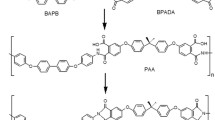Abstract
Shape-memory polymers have attracted a lot of interest in recent years. A shape-memory polymer can be deformed and fixed into a temporary shape and subsequently made to recover its original shape when a suitable stimulus is applied. This is accomplished by means of a thermomechanical cycle called programming. Programming can be performed in a stress- or strain-controlled mode. The thermomechanical conditions of the programming affect shape-memory properties differently in each programming mode. One of the parameters which significantly affects shape-memory properties in a stress-controlled procedure is stress-holding time (t H) at high temperature. This paper studies how stress-holding time affects the most significant shape-memory properties under successive thermomechanical cycles. The experiments were conducted using two different programming temperatures in the vicinity of the T g. The shape-recovery ratio decreased dramatically with cycling even when the holding time was just a few seconds, however, the impact of the stress-holding time depends on the temperature at which it has been applied. Shape-fixity ratio and switching temperature were also studied, but stress-holding time and successive cycles do not seem to affect either of these factors.






Similar content being viewed by others
References
A. Lendlein and S. Kelch, Shape-Memory Polymers, Angew. Chem. Int., 2002, 41(12), p 2034–2057
B. Atli, F. Gandhi, G. Karst, Thermomechanical characterization of shape memory polymers, Proceedings of SPIE—The International Society for Optical Engineering, San Diego, CA, Vol 6524, 2007
J. Cui, K. Kratz, and A. Lendlein, Adjusting shape-memory properties of amorphous polyether urethanes and radio-opaque composites thereof by variation of physical parameters during programming, Smart Mater. Struct., 2010, 19(6), p 065019
J.L. Hu, F.L. Ji, and Y.W. Wong, Dependency of the shape memory properties of a polyurethane upon thermomechanical cyclic conditions, Polym. Int., 2005, 54(3), p 600–605
C. Schmidt, K. Neuking, G. Eggeler, Functional fatigue of shape-memory polymers, Materials Research Society Symposium Proceedings, San Francisco, CA, Vol 1190, 2009, p 43–48
A.J.W. McClung, G.P. Tandon, and J.W. Baur, Deformation rate-, hold time-, and cycle-dependent shape-memory performance of Veriflex-E resin, Mech. Time Depend. Mater., 2013, 17, p 39–52
C. Azra, C.J.G. Plummer, and J.-A.E. Månson, Isothermal recovery rates in shape memory polyurethanes, Smart Mater. Struct., 2011, 20(8), p 082002
H.J. Tobushi, S. Hayashi, K. Hoshio, and N. Miwa, Influence of strain-holding conditions on shape recovery and secondary-shape forming in polyurethane-shape memory polymer, Smart Mater. Struct., 2006, 15(4), p 1033–1038
A.J.W. McClung, G.P. Tandon, and J.W. Baur, Fatigue cycling of shape memory polymer resin, Conference Proceedings of the Society for Experimental Mechanics Series, Vol 3, 2011, p 119–127
C. Schmidt, A.S. Chowdhury, K. Neuking, and G. Eggeler, Studies on the cycling, processing and programming of an industrially applicable shape memory polymer Tecoflex® (or TFX EG 72D), High Perform. Polym., 2011, 23(300), p 300–307
H. Tobushi, H. Hara, E. Yamada, and S. Hayashi, Thermomechanical properties in a thin film of shape memory polymer of polyurethane series, Smart Mater. Struct., 1996, 5(4), p 483–491
C. Liu, H. Qin, and P.T. Mather, Review of progress in shape-memory polymers, J. Mater. Chem., 2007, 17(16), p 1543–1558
J. Cui, K. Kratz, M. Heuchel, B. Hiebl, and A. Lendlein, Mechanically active scaffolds from radio-opaque shape-memory polymer-based composites, Polym. Adv. Technol., 2011, 22(1), p 180–189
Acknowledgments
The authors would like to thank MINECO (MAT2011-27039-C03-01, MAT2011-27039-C03-02) for giving financial support.
Author information
Authors and Affiliations
Corresponding author
Rights and permissions
About this article
Cite this article
Santiago, D., Ferrando, F. & De la Flor, S. Influence of Holding Time on Shape Recovery in a Polyurethane Shape-Memory Polymer. J. of Materi Eng and Perform 23, 2567–2573 (2014). https://doi.org/10.1007/s11665-014-0997-5
Received:
Revised:
Published:
Issue Date:
DOI: https://doi.org/10.1007/s11665-014-0997-5




